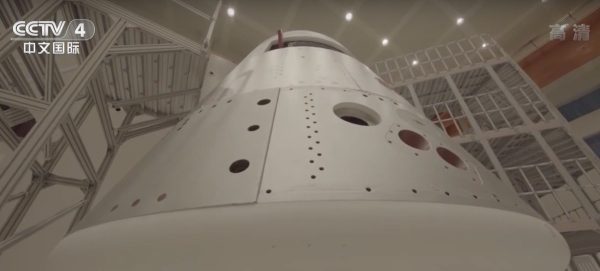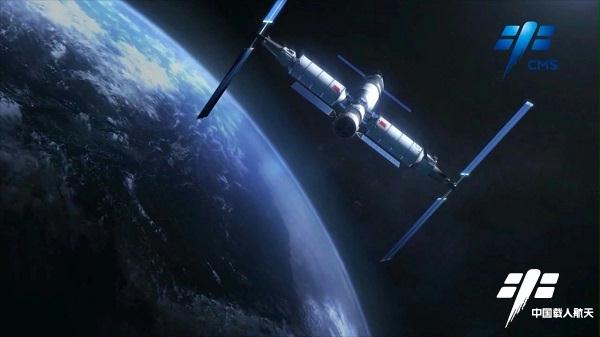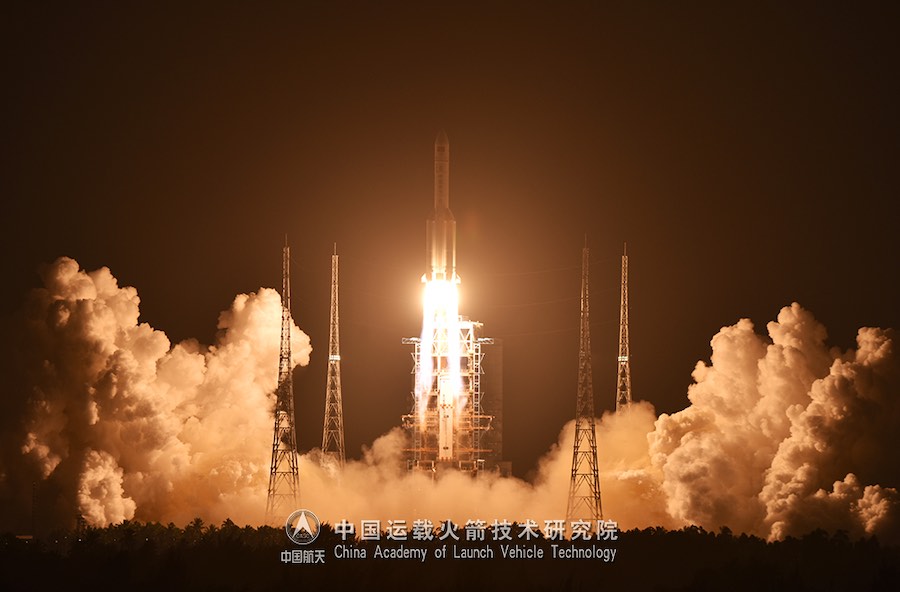Prototypes for new Chinese crew capsule and space station arrive at launch site – Spaceflight Now

The next flight of China’s heavy-lift Long March 5 rocket will debut a new configuration designed to launch modules for a Chinese space station. But a demonstration launch of the Long March 5B booster scheduled as soon as April will instead carry a prototype of China’s next-generation deep space crew capsule into orbit on an unpiloted test flight.
The crew capsule prototype has arrived at the Wenchang launch base, located on Hainan Island in southern China, the China Manned Space Engineering Office announced Jan. 20. A test unit for the core module of China’s planned space station also arrived via ship at the Wenchang space base to undergo rehearsals before the core module flight unit launches on a Long March 5B rocket in 2021, officials said.
The space station core module is named Tianhe, and it will form the centerpiece of China’s space station. Two experimental modules will launch on subsequent Long March 5B rockets to complete the initial assembly of the orbiting space station complex by 2022.
The station will accommodate crews of three astronauts on missions lasting up to six months, according to previous statements by Chinese officials.
The crews are expected to initially fly to and from the space station on Chinese Shenzhou spacecraft, which have flown on six piloted missions to low Earth orbit since 2003. But later crews could fly on a next-generation spaceship, a prototype of which will fly on top of China’s first Long March 5B rocket this spring.

The Long March 5B rocket is a variant of China’s Long March 5 rocket family tailored to haul heavy payloads into low Earth orbit.
Flying without a second stage, the Long March 5B will carry its payloads into space using just its core stage and four strap-on liquid-fueled boosters. Large payloads will occupy the second stage’s volume on the Long March 5B, which can deliver up to 55,000 pounds (25 metric tons) of payload to low Earth orbit.
China has performed three Long March 5 launches to date, all using a variant with a powered second stage.
The second Long March 5 flight in 2017 ended in failure due to an engine malfunction on the rocket’s first stage. After a two-and-a-half-year grounding to resolve the problem, China resumed Long March 5 launches Dec. 27 with a successful flight to deliver an experimental communications satellite to orbit.
The return-to-flight of the Long March 5 allowed Chinese officials to move forward with a series of high-profile launches in 2020. The Long March 5B launch with the prototype crew capsule is next in line, followed by the launch of a Long March 5 in July with China’s first Mars rover, and a flight later in 2020 with Chang’e 5, a robotic mission to attempt to return samples from the lunar surface back to Earth.
The China Manned Space Engineering Office, which oversees China’s human spaceflight program, announced Jan. 20 that manufacturing and testing of the first Long March 5B rocket was completed at a factory in Tianjin, located in northern China. The rocket hardware will be transported by ship to Hainan Island, where it is scheduled to arrive in early February, officials said.
Previous Long March 5 launch campaigns required about two months from the time of the rocket’s arrival at the Wenchang spaceport until liftoff. If Chinese teams follow that precedent, the Long March 5B launch could occur as soon as April.

The Long March 5B rocket will loft China’s next-generation crewed spacecraft into orbit on a three-day test flight before the capsule returns to Earth for a parachute-assisted landing.
The spacecraft will fly in an elliptical orbit stretching several thousand miles from Earth, allowing it to re-enter the atmosphere at higher speeds than if it returned from low Earth orbit, where the Chinese space station will fly. The higher-speed re-entry will allow engineers to test the performance of the capsule’s heat shield at hotter temperatures closer to the conditions a spaceship would encounter during a return from the moon.
The test flight profile appears similar to the Experimental Flight Test of NASA’s Orion deep space crew carrier in 2014.
China’s new crewed spacecraft will not fly with any astronauts on the test flight later this year, but Chinese officials said it will be eventually be used to transport crews to the country’s space station, and to carry astronauts on missions to the moon.
The crew module of China’s new human-rated spacecraft is designed to be reusable, and it will return to Earth and touch down on land with a cushion from inflatable air bags, similar to the design employed by Boeing’s Starliner crew capsule.
Chinese state television broadcast a video of a drop test of the crew capsule to monitor the performance of the airbag system.
“In the past, the thermal protection of Shenzhou spaceships were integrated with the metal structure inside, so the entire thermal protection structure could not be disassembled, and capsule was not usable after coming back to Earth,” said Yang Qing, chief designer of the new crew spacecraft at the China Academy of Space Technology.
“This time, the heat protection on all our cabins has been turned into pieces, which is very convenient to disassemble. It is equivalent to removing the skin of a melon and reusing the pulp inside,” he said. “To ensure a sustainable development of the whole industry in the future, cost reduction is still a very critical factor, so being reusable is a better way for us to reduce the cost.”
Huang Zhen, chief assistant designer of China’s new crew spacecraft, said the capsule uses new heat-resistant materials. The thermal shielding is a third the density of the heat shield on the Shenzhou spacecraft, but is capable of withstanding hotter temperatures, he said.
“We also upgraded our control on the return trip, which means we will further improve the accuracy of the landing point, and at the same time make sure that astronauts can withstand the impact,” Huang said.
The primary objectives of the test flight this spring including testing the heat shield, re-entry control and parachutes, Chinese officials said.
The next-generation vehicle can carry three astronauts, plus up to 1,100 pounds (500 kilograms) of cargo, officials said. The capability will allow China to return research specimens and hardware from the country’s space station back to Earth.
“We will have some experiments with microbes and some goods manufactured in space, and there is no way to bring them back to Earth for better research,” Huang said. “We can use Tianzhou cargo spacecraft to take the goods to the space station. Meanwhile, we can also use our new generation of spacecraft to bring the finished products back from space. ”
Yang said the prototype crew capsule slated to fly on the Long March 5B test launch this spring will be loaded with nearly 10 metric tons (22,000 pounds) of propellant, enabling extensive maneuvers in orbit. The fuel load will also match the spacecraft’s weight to the expected launch weight of the Tianhe core module for China’s space station.
“We will use the weight as a standard for the test launch,” Yang said.
With its propulsion and power module, the crew spacecraft measures nearly 29 feet (8.8 meters) long. It will weigh around 47,600 pounds (21.6 metric tons) fully loaded with equipment and propellant, according to the China Manned Space Engineering Office, or CMSEO.
The Tianhe module for China’s space station is larger in size, with a length of more than 54.4 feet (16.6 meters), a maximum diameter of around 13.8 feet (4.2 meters), and a launch weight of roughly 49,600 pounds (22.5 metric tons), CMSEO said in a statement.
Email the author.
Follow Stephen Clark on Twitter: @StephenClark1.






